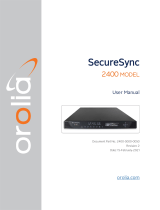
3. Mount the pipe nipple to a fixture, such as the side or top of a building, or to a pipe. You
may also purchase the antenna mounting kit available from Arbiter Systems.
4. Also available is a surge arrester that can protect the Model 1133A from induced voltages
that may appear on the antenna cable.
5. Connect the antenna cable to the clock so the clock can synchronize with the GNSS.
Inlet Power Connection
Arbiter Systems does not provide a power cord for the 1133A. Because each installation is unique,
the inlet power cord and connection are the responsibility of the user. Inlet power is supplied from
an AC or DC power source to the three-terminal block at the right rear of the 1133A. Identification
marks are there for assignment of correct polarity. Caution: Polarity markings are especially
important for DC power sources.
Power cords should be of appropriately-rated, two or three-conductor insulated wire. Strip the wire
at the 1133A end about 1/4 inch (7 mm) and Do NOT tin with solder.
System Ground
A threaded ground lug labeled SURGE, found near the inlet power terminal strip, is provided for
electrical surges and as a safety ground. Caution: Always connect the chassis to a suitable system
ground, otherwise dangerous voltages could appear at the 1133A.
Confirming Basic Operation
Prior to configuring the measured electrical system inputs and outputs on the 1133A, follow these
steps to confirm normal operation.
1. Locked Condition: After application of line power, the 1133A should lock to the GNSS for
the first time within about 25 minutes (antenna connected).
LOCKED
VISIBLE=11 TRACKED=8
If the 1133A is equipped with a BNC connector for an IRIG-B synchronizing input signal, it
should quickly synchronize after connecting an IRIG-B000 unmodulated signal.
2. If necessary, press the STATUS/TIME key until the display indicates the receiver condition
shown above.
3. Check OPERATE and TIME SET LEDs – they are green and SHOULD be lit.
4. Check UNLOCKED and FAULT LEDs – they are red and SHOULD NOT be lit.
5. Position and Time: Press the STATUS/TIME key until the display indicates the geographical
position of the GNSS antenna. Your position will be different.
LAT 35
◦
35’ 50.18"
LON 120
◦
41’ 34.83"
6. It may be advisable to write down the longitude and latitude for future reference.
7. Other Display Indications: see Chapter 5 in the manual. If any of the display indications do
not seem correct, check the operation manual, and if necessary, contact the factory technical
support for help. Contact information is found at the bottom of the last page.
2












